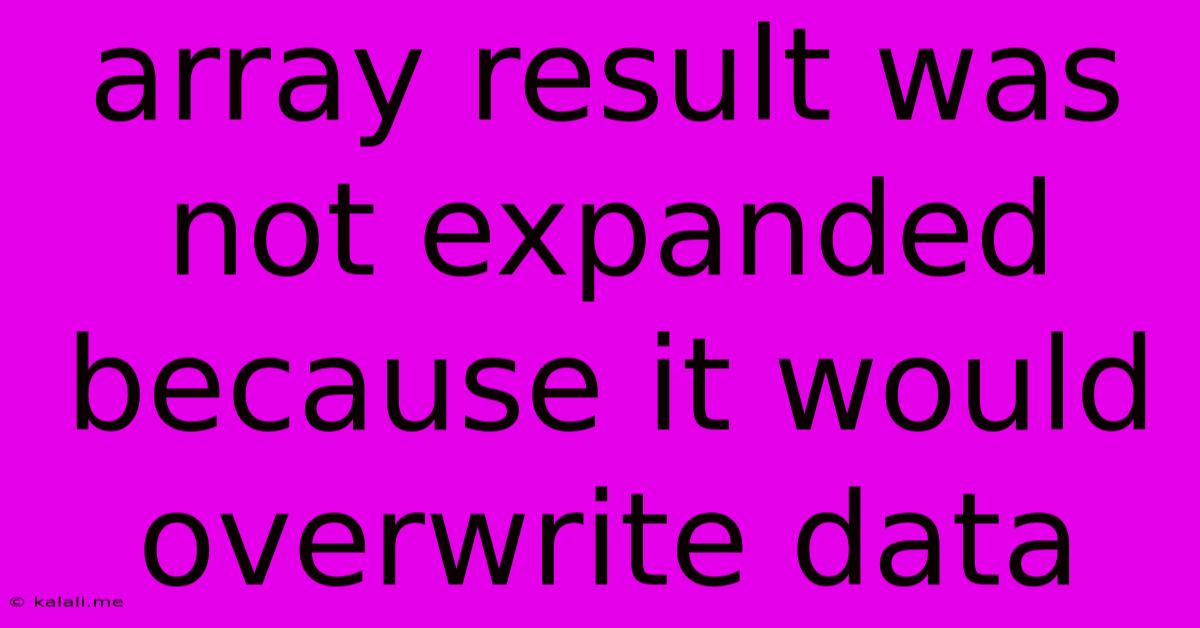Array Result Was Not Expanded Because It Would Overwrite Data
Kalali
Jun 08, 2025 · 4 min read

Table of Contents
Array Result Was Not Expanded Because It Would Overwrite Data: Troubleshooting and Solutions
This error message, "Array result was not expanded because it would overwrite data," typically arises in programming contexts, particularly when working with data structures like arrays or spreadsheets where you're attempting to insert or append data that conflicts with existing data. Understanding the root cause and implementing appropriate solutions is crucial for maintaining data integrity and ensuring smooth program execution. This article delves into the common causes of this error and provides practical strategies for resolving it.
Understanding the Error
The core problem lies in a conflict between the intended operation (expanding an array or adding data) and the existing data within the target location. The system prevents the operation to avoid unintended data loss or corruption. This often happens when:
- Overlapping Indices: You're trying to insert data at an index that already holds data, leading to a potential overwrite.
- Fixed-Size Arrays: If you're working with arrays that have a predetermined size, exceeding that limit will trigger this error.
- Data Structure Constraints: Certain data structures might have built-in limitations that prevent overwriting existing elements.
- Conflicting Updates: Simultaneous updates or modifications to the same data location from multiple processes or threads can lead to this error.
Common Scenarios and Solutions
Let's explore some common scenarios where you're likely to encounter this error and the best ways to address them.
1. Array Appending and Insertion
- Problem: Trying to add an element to an array at an index that already contains data.
- Solution: Instead of direct insertion at a potentially occupied index, use array methods designed for appending (like
push()orappend()in many languages) or inserting elements at the end. If insertion at a specific position is required, ensure the index is valid and available. Consider usingsplice()or similar functions for careful insertion without overwriting.
2. Spreadsheet or Database Operations
- Problem: Updating data in a spreadsheet or database where the new data conflicts with existing entries.
- Solution: Thoroughly check for existing data before performing updates. Use appropriate
WHEREclauses in SQL queries or equivalent functions in spreadsheet software to target specific rows for modification. Utilize unique identifiers (primary keys in databases) to prevent accidental overwrites. Implement error handling to catch and manage potential conflicts.
3. Working with Fixed-Size Arrays
- Problem: Attempting to add data to a fixed-size array that's already full.
- Solution: Use dynamic arrays (or lists) which can resize automatically as needed. If using a fixed-size array is mandatory due to performance considerations, ensure you have sufficient space allocated before adding new data. Implement error handling to catch and manage attempts to exceed the array's capacity.
4. Concurrency Issues
- Problem: Multiple processes or threads trying to modify the same array concurrently.
- Solution: Implement proper synchronization mechanisms like locks (mutexes, semaphores) or atomic operations to prevent race conditions where simultaneous updates lead to data inconsistencies. Use thread-safe data structures if your language provides them.
5. Debugging Techniques
- Print Statements: Strategically placed
print()orconsole.log()statements can help pinpoint the exact location and state of the array when the error occurs. - Debuggers: Use a debugger to step through the code line by line and inspect variable values, allowing you to identify the point where the overwrite attempt is made.
- Logging: Implement logging to record important actions and array states, facilitating the identification of the root cause.
Preventing Future Errors
- Input Validation: Rigorously validate user inputs or data sources before attempting to insert or update arrays to ensure that the data is compatible with your data structures.
- Clear Error Handling: Implement comprehensive error handling to gracefully manage potential issues like this, preventing program crashes and providing informative error messages to the user.
- Careful Planning: Before writing any data manipulation code, meticulously plan the structure and intended operations on your data to avoid unexpected conflicts.
By understanding the root cause and implementing the solutions described above, you can effectively address the "Array result was not expanded because it would overwrite data" error and maintain the integrity of your data. Remember that careful planning, comprehensive error handling, and using appropriate data structures are key to preventing this error from occurring in the first place.
Latest Posts
Latest Posts
-
A Woman Shall Leave Her Home Bible Verse
Jun 08, 2025
-
Find Ip Address Of Salesforce Org
Jun 08, 2025
-
Fix The Shelf In The Kitchen
Jun 08, 2025
-
When Does A Router Use Arp
Jun 08, 2025
-
Will Flour Put Out A Fire
Jun 08, 2025
Related Post
Thank you for visiting our website which covers about Array Result Was Not Expanded Because It Would Overwrite Data . We hope the information provided has been useful to you. Feel free to contact us if you have any questions or need further assistance. See you next time and don't miss to bookmark.